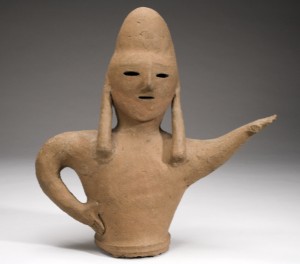Haniwa Tomb Figure of a Soldier

This ancient clay doll is of a type known as haniwa, funerary objects that surrounded the above-ground tombs of emperors and nobles during the late Kofun (also known as Tumulus) period of Japan (200-710). These terracotta sculptures ranged from human figures of all occupations to animals, armor, weapons, and even small replicas of houses. Haniwawere set in carefully composed scenes upon the terraces of the tomb mounds. It is unknown if they were meant to serve as guardians of the grave, or as items and servants the deceased could carry with them to the afterlife.
This haniwa lacks detailed clothing or accessories, leaving his social standing unclear, but his headdress and braided hairstyle indicate that he is male. The bottom half of this figure has been lost; typically, the lower half of a haniwa would have a long cylindrical base that was set into the ground. Some figures were also decoratively painted with red ochre. Like this man, many figures have simple incised holes for eyes and mouths, and appear to be singing or speaking. The delicate detailing of eyebrows, cheekbones, and individual fingers, along with the smooth, minimally decorated surface of this figure date it as a later form of haniwa, which became increasingly simplified as the demand for the figures grew over time. As ancient Japanese civilization changed from an agrarian society to a feudal system, the growing number of nobles entombed required thousands of haniwa, many of which are still being discovered today.Haniwa provide Japanese archaeologists with a valuable glimpse of the roles and values that characterized early Japan, but their charming simplicity and unassuming demeanor make them an appealing art form to all who encounter them.
This work is currently on view in the Elizabeth Rickey Bevington and Leila Hammond Duncan Gallery on the fourth floor of the museum.
Darcy Kupferschmidt ’12
Curatorial Intern, Summer 2012